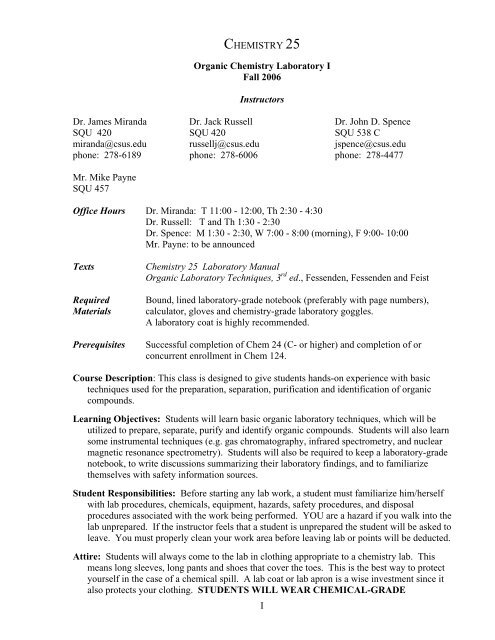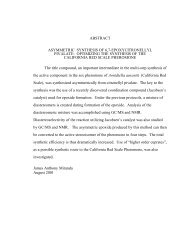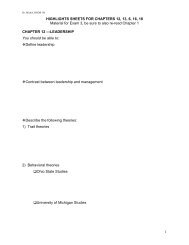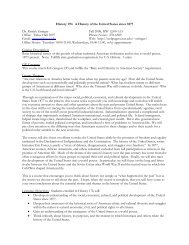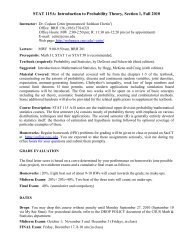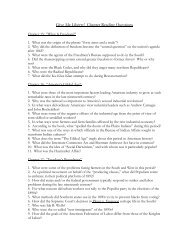I CHEMISTRY 25 Organic Chemistry Laboratory I Fall 2006 ...
I CHEMISTRY 25 Organic Chemistry Laboratory I Fall 2006 ...
I CHEMISTRY 25 Organic Chemistry Laboratory I Fall 2006 ...
You also want an ePaper? Increase the reach of your titles
YUMPU automatically turns print PDFs into web optimized ePapers that Google loves.
<strong>CHEMISTRY</strong> <strong>25</strong><strong>Organic</strong> <strong>Chemistry</strong> <strong>Laboratory</strong> I<strong>Fall</strong> <strong>2006</strong>InstructorsDr. James Miranda Dr. Jack Russell Dr. John D. SpenceSQU 420 SQU 420 SQU 538 Cmiranda@csus.edu russellj@csus.edu jspence@csus.eduphone: 278-6189 phone: 278-6006 phone: 278-4477Mr. Mike PayneSQU 457Office Hours Dr. Miranda: T 11:00 - 12:00, Th 2:30 - 4:30Dr. Russell: T and Th 1:30 - 2:30Dr. Spence: M 1:30 - 2:30, W 7:00 - 8:00 (morning), F 9:00- 10:00Mr. Payne: to be announcedTextsRequiredMaterialsPrerequisites<strong>Chemistry</strong> <strong>25</strong> <strong>Laboratory</strong> Manual<strong>Organic</strong> <strong>Laboratory</strong> Techniques, 3 rd ed., Fessenden, Fessenden and FeistBound, lined laboratory-grade notebook (preferably with page numbers),calculator, gloves and chemistry-grade laboratory goggles.A laboratory coat is highly recommended.Successful completion of Chem 24 (C- or higher) and completion of orconcurrent enrollment in Chem 124.Course Description: This class is designed to give students hands-on experience with basictechniques used for the preparation, separation, purification and identification of organiccompounds.Learning Objectives: Students will learn basic organic laboratory techniques, which will beutilized to prepare, separate, purify and identify organic compounds. Students will also learnsome instrumental techniques (e.g. gas chromatography, infrared spectrometry, and nuclearmagnetic resonance spectrometry). Students will also be required to keep a laboratory-gradenotebook, to write discussions summarizing their laboratory findings, and to familiarizethemselves with safety information sources.Student Responsibilities: Before starting any lab work, a student must familiarize him/herselfwith lab procedures, chemicals, equipment, hazards, safety procedures, and disposalprocedures associated with the work being performed. YOU are a hazard if you walk into thelab unprepared. If the instructor feels that a student is unprepared the student will be asked toleave. You must properly clean your work area before leaving lab or points will be deducted.Attire: Students will always come to the lab in clothing appropriate to a chemistry lab. Thismeans long sleeves, long pants and shoes that cover the toes. This is the best way to protectyourself in the case of a chemical spill. A lab coat or lab apron is a wise investment since italso protects your clothing. STUDENTS WILL WEAR CHEMICAL-GRADEI
LABORATORY GOGGLES AT ALL TIMES IN THE LABORATORY. THEREARE NO EXCEPTIONS. Any student who must be repeatedly warned to put on his/hergoggles will be told to leave the class. Contact lenses should never be worn in achemistry laboratory.Experiments: The experiments to be performed this semester are listed below in the approximate order inwhich they will be carried out, along with the point values for each experiment. Points for eachexperiment are based on your data obtained in lab, data analysis, report sheets and your notebook.PointsExperiment and Reading Assignment30 Thermometer Calibration and Melting Points, with UnknownRead: Text: pp. 1-22, 213-221, 39-48, and Lab Manual: Experiment #1 and Appendix VI50 Recrystallization, with UnknownRead: Text: pp. 23-38, and Lab Manual: Experiment #230 Micro Boiling Points, with UnknownRead: Text: p. 90, and Lab Manual: Experiment #350 Distillation (simple and fractional) and Gas Chromatography (GC)Read: Text: pp. 71-75, 77-92, 93-97, 107-110, 141-152,Lab Manual: Experiment #4 and Appendix III50 Thin Layer Chromatography (TLC), with UnknownRead: Text: pp. 133-140, and Lab Manual: Experiment #550 Column Chromatography/SynthesisRead: Text: pp. 119-131, 153-162 and Lab Manual: Experiment #650 Liquid-Liquid Extraction/SynthesisRead: Text: pp. 49-76, 163-178, 206-7, Lab Manual: Experiment #7, Appendix IV and V70 Qualitative Analysis of Carbonyl Compounds, with UnknownRead: Lab Manual: Experiment #8, Appendix I, II, IV and V70 Grignard Synthesis of Benzoic AcidsRead: Lab Manual: Experiment #9, Appendix IV and V50 Nitration of Methyl BenzoateRead: Lab Manual: Experiment #10, Appendix IV and V50 Aldol CondensationRead: Lab Manual: Experiment #11, Appendix IV and VAttendance: Students are expected to attend all laboratory lectures (attendance will be taken).Students missing two or more lectures will lose 10% of the corresponding experiment grade forevery lecture missed. Students who miss two or more lab sessions without an excuse will fail theclass. Students will work only during their assigned lab time, and may NOT work during anotherII
lab time without prior permission of all instructors affected by the scheduling change. Nomaterials, chemicals or supplies, may be removed from the lab without permission of theinstructor.Experiment Points: Your points for each experiment will be based on a completed pre-lab andpost-lab report sheet, spectral data, graphs and purity/quantitiy of chemicals synthesized in the labturned-in in a properly labeled vial (student name, compound name, experiment title, weight, mprange). The pre-lab reports are due at the beginning of each experiment while the post-lab reportsare due one week after the posted end date for that lab experiment. All lab reports are due at thebeginning of the laboratory period in which they are due. Late materials will be accepted onlywithin one week of the due date unless prior permission of the instructor is obtained, and latematerial will lose 10% of its assigned value with each day it is late.Exams: There will be two exams given. The first will be given half way through the courseduring the discussion hour, tentatively planned for the week of 10/30. There will also be an examgiven during finals week (see schedule below).Grading: Your grade for the course will be based on your experiment points, exams, yourlaboratory notebook, including a hazard table, and your laboratory technique throughout thecourse of the semester (see below for instructions on keeping a laboratory notebook).Lab book and technique 50Hazard Table 50Experimental points 550Exams (2) 300Total950 pts.Letter grades are assigned based on a range of: A to A- = 90.0% and above, B+ to B- = 89.9-80.0%, C+ to C- = 79.9-70.0%, D+ to D- = 69.9-60.0%, F = below 60.0%Cheating: Cheating in any form is not tolerated in this class. A student caught cheating willreceive a zero on that experiment/exam. If a student is caught a second time, the student will failthis course. Cheating includes: copying from another student's report (yes, even lab partners musthave their own unique answers), copying material or data from a previous report (your own orsomeone else's), turning in lab work done during a previous semester, reporting data for anexperiment you did not perform, using extra materials during testing, programming data into acalculator, having other people take tests for you, altering exams after they have been graded, etc.<strong>Laboratory</strong> Notebook: Read text pp. 8-22, 197-202. The correct notebook for the lab is ahardcover, bound notebook containing lined pages. A loose-leaf or spiral notebook is notsatisfactory because pages are easily removed and lost. A separate notebook should be used foreach laboratory course. If the pages are not numbered, number them before using the book.Make sure you write your name, address, and telephone number on the inside cover, in case it islost. Record your locker number and combination of your locker in your lab book or in someconvenient place. Leave two pages at the front of the lab book for a table of contents. Thenenter your experiments consecutively. All data will be recorded in permanent ink as it iscollected. NEVER ERASE IN A NOTEBOOK. If an error is made, ONE line is drawn throughthe mistake. DO NOT SCRATCH OUT ERRORS AND DO NOT RIP OUT PAGES FROMTHE LAB BOOK. Points will be deducted for illegible notebooks, however we do understandIII
that the only "perfect" lab book is one that has been copied. Make sure your work is neat andeasily followed.The format for writing experiments in your laboratory notebook is as follows:Date-date experimental work performed. NEVER FORGET TO DATE YOUR WORK–inthe real world this can mean the difference between getting a patent and losing it tosomeone else.Title – name of experimentEquations – you should write a complete and balanced equation for any reaction taking placein the experiment performed. Under each of the starting materials you should list themolecular weight of each compound, the amount you intend to use in the experiment, andspace to write in the actual amount used.Procedure Outline – the outline should include sufficient detail to carry out the experimentwithout referring to the original experiment in the book. DON’T COPY WORD FORWORD, (it’s a waste of time!!) and long paragraphs make it hard to quickly determineyour next step.Your lab instructor will check your lab book for these four sections beforeyou are allowed to begin any experiment.Observations and Experimental Data – Data describing the experiment: dates, exact weights,color changes, phase changes, nature of the products, sudden volcanic eruptions or lackthereof, observed temperatures, etc. What you did a little differently than the originalprocedure. Also give any factors that might have influenced the outcome of theexperiment, or reasons why you chose one method over another (why one solvent and notanother, particularly important in recrystallization and purification experiments). Includeany data you collected during the experiment in a form that makes it easy for you tofollow, for example, in Experiment #1 a table with seven columns would work well: (1)the name and (2) the structure of the compounds, (3) reagent bottle melting points, (4 &5) experimental data (two trials), (6) the average melting point, and (7) the correctionfactor you calculate based on the difference between the real melting point and theaverage observed melting point.Conclusions – Brief analysis of the outcome of the experiment, for example: name andstructure of the identified unknown, calculation for yield of a product (always showcalculations), physical constants measured in an experiment, purity found by analysis, acomparison of observed versus literature values for physical properties written as a 2-3sentence summary.<strong>Laboratory</strong> Safety: Read text pp. 1-8, 213-221. Since most organic compounds are potentiallyvolatile, flammable and toxic either alone or in combination, a student must become familiarwith the chemical and physical properties of all the substances with which they work. Theseproperties can be found in the MSDS (Material Safety Data Sheet), which is available on theInternet web sites of many companies (Acros, Baker, Sigma-Aldrich) and Universities (Cornell,Vermont SIRI, Oklahoma State University). Cambridge Scientific sponsors a ChemFinder webIV
site. The MSDS's are on file in the service center, and there is a computer kiosk at the end of the5 th floor near the ice machine where you may also look up your MSDS data. In the CSUSLibrary web page under the <strong>Chemistry</strong> databases you will find a link to many of these on-lineMSDS sites.You will devote the last 10-15 pages of your lab book to listing the following types ofinformation about chemicals used in the lab. (You only need to list a chemical once, even if it isused in many different experiments - plan for about 80 chemical citations). Turn your booksideways and make a table with the following columns:1. Chemical name2. Structure3. Melting point for solids / Boiling points for liquids4. Density for liquids5. An oral LD 50 (lethal dose with 50% kill rate)6. Exposure Dangers – is it a carcinogen or potential carcinogen? Something worse?7. Incompatibilities8. Other Notes (if you find something else you want to remember about the compound)Special Needs: Students requiring special accommodations should see the instructor as soon aspossible. Students who are pregnant should consult with the instructor and their physicianbefore undertaking any lab work.Tentative <strong>Laboratory</strong> Schedule (<strong>Fall</strong> <strong>2006</strong>)Week of: LECTURE LAB #1 LAB #2Week 1 (9/4) Review NO LAB ReviewWeek 2 (9/11) MP/Recryst. Check in MPWeek 3 (9/18) Recryst. MP/ Recryst.Week 4 (9/<strong>25</strong>) Recryst./BP/Distill. Recryst. Recryst.Week 5 (10/2) Distill./GC BP BP/Distill.Week 6 (10/9) TLC Distill/GC Distill/GCWeek 7 (10/16) Column Chrom. TLC TLC/Column Chrom.Week 8 (10/23) Extraction Column Chr. Column Chr.Week 9 (10/30) Exam 1 Extraction ExtractionWeek 10 (11/6) Carbonyl Carbonyl Unk. Carbonyl Unk.Week 11 (11/13) Carbonyl Carbonyl Unk. Carbonyl Unk.Week 12 (11/20) Grignard Grignard NO LABWeek 13 (11/27) Nitration Grignard NitrationWeek 14 (12/4) Aldol Nitration AldolWeek 15 (12/11) Review Aldol CheckoutV
FINAL EXAMINATIONS:Monday Lecture: Monday December 18, 12:45 – 2:45Tuesday Lecture: Thursday December 21, 12:45 – 2:45VI


